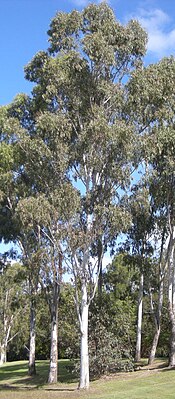Eucalyptus tereticornis
| Eucalyptus tereticornis | ||||||||||||
|---|---|---|---|---|---|---|---|---|---|---|---|---|

Eucalyptus tereticornis |
||||||||||||
| Systematics | ||||||||||||
|
||||||||||||
| Scientific name | ||||||||||||
| Eucalyptus tereticornis | ||||||||||||
| Sm. |
Eucalyptus tereticornis is a species ofthe myrtle family (Myrtaceae). It occurs in southern Papua New Guinea and on the east coast of Australia and is called “Forest Red Gum”, “Bastard Box”, “Blue Gum”, “Flooded Gum”, “Gray Gum”, “Mountain Gum”, “Queensland Blue” Gum ”,“ Red Gum ”,“ Red Ironbark ”,“ Red Irongum ”or“ Slaty Gum ”.
description
Appearance and leaf
Eucalyptus treticornis grows as a tree that can reach heights of up to 50 meters. The bark is smooth and white or gray all over the tree. It peels off in large sheets or scales. The small branches are green. There are no oil glands in the bark or in the marrow.
In Eucalyptus treticornis , heterophylly is present. The leaves on young specimens are broadly lanceolate to ovate and shiny green. The single-colored, matt green leaves on adult specimens are narrow-lanceolate to lanceolate with a length of 10 to 20 cm and a width of 1 to 3 cm. The lateral nerves are raised, pointed or blunt and have medium spacing. The 13 to 24 mm long petioles are narrowly flattened or channel-shaped in cross section.
Inflorescence and flower
On a 7 to 25 mm long inflorescence stem, which is narrowly flattened or angular in cross-section, there are approximately seven, rarely eleven-flowered partial inflorescences . The peduncle is 3 to 10 mm long. The cylindrical or spindle-shaped flower buds are 10 to 20 mm long and 4 to 8 mm in diameter. The calyptra is elongated-pointed or conical, longer and wider than the flower cup (hypanthium) and falls off early. The flower cup and calyptra are smooth. The flowers are creamy white.
fruit
The fruit is spherical or egg-shaped with a length of 4 to 6 mm and a diameter of 4 to 8 mm. The disc is raised, the fruit fans protrude.
Occurrence
The natural range of Eucalyptus tereticornis is in the south of Papua New Guinea and along the east coast of Australia from Queensland to eastern Victoria , as well as in the tabular country of New England .
Eucalyptus tereticornis grows in grassy, dry or humid forests and is often dominant in these locations. The species prefers soils with medium to high nutrient content. In many habitats, such as the upper reaches of the Hunter River , the Goulburn River , the Coxs River and Kowmung River , Eucalyptus tereticornis occurs together with Eucalyptus blakelyi .
Taxonomy
The first samples of Eucalyptus tereticornis were collected by John White , First Fleet expedition doctor and naturalist. James Edward Smith then carried out the first description in 1793 in his work "Zoology and Botany of New Holland" created together with George Shaw . The type material has the inscription "New South Wales, Port Jackson, J. White 1793". In 1795 the work was reissued under the title "A Specimen of the Botany of New Holland". There, in Volume 4 on page 41, Eucalyptus tereticornis is described. The specific epithet tereticornis is composed of the Latin words teretus for round stem and cornu for horn. This indicates the shape of the bud envelope.
Synonyms for Eucalyptus tereticornis Sm. Are Eucalyptus subulata Schauer , Leptospermum umbellatum Gaertn. , Eucalyptus umbellata var. Pruniflora Blakely , Eucalyptus tereticornis var. Pruniflora (Blakely) Cameron , Eucalyptus insignis Naudin and Eucalyptus populifolia Desf.
There are a number of varieties that are not widely recognized.
Eucalyptus tereticornis forms where it with Eucalyptus robusta socialized frequently, is a hybrid that the name Eucalyptus patentinervis received. Other, less common hybrids are known.
use
Wood
Eucalyptus tereticornis provides a hard, resistant heartwood with a specific weight of around 1100 kg / m³. It is used as construction and lumber, e.g. B. for railway sleepers used.
Eucalyptus oil
Cineol-based eucalyptus oil is obtained from the leaves of Eucalyptus tereticornis .
Individual evidence
- ↑ a b c D. J. Boland et al .: Forest Trees of Australia . 4th edition. CSIRO Publishing, Collingwood VIC 1985, ISBN 0-643-05423-5 . The source was available to the author of the article in the en: WP.
- ↑ Enter Eucalyptus tereticornis in the search mask of the Australian Plant Common Name Database , Australian National Botanic Gardens . Retrieved January 28, 2013
- ↑ a b c d e f g K. Hill: Eucalyptus tereticornis (Sm.) At New South Wales Flora Online . National Herbarium of NSW, Royal Botanic Garden, Sydney. Retrieved January 28, 2013
- ↑ a b c d e Eucalyptus tereticornis at EucaLink - A Web Guide to the Eucalypts . Retrieved January 28, 2013.
- ↑ James Edward Smith: A Specimen of the Botany of New Holland . James Sowerby, London 1793. Source was available to the author of the article in the en: WP.
- ↑ a b c APNI = Australian Plant Name Index . Center for Plant Biodiversity Research. Australian Government. Retrieved January 28, 2013
- ↑ Rafaël Govaerts (ed.): Eucalyptus tereticornis. In: World Checklist of Selected Plant Families (WCSP) - The Board of Trustees of the Royal Botanic Gardens, Kew . Retrieved January 28, 2013.
- ^ DJ Boland et al .: Forest Trees of Australia . 4th edition. CSIRO Publishing, Collingwood VIC 1984, ISBN 0-643-05423-5 . The source was available to the author of the article in the en.WP.
- ↑ DJ Boland, JJ Brophy & APN House: Eucalyptus Leaf Oils . 1991, ISBN 0-909605-69-6 . The source was available to the author of the article in the en: WP.

